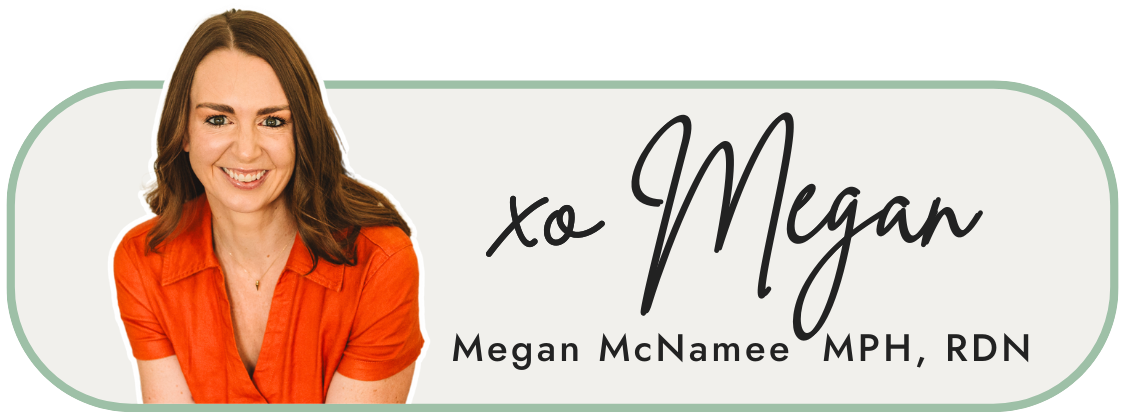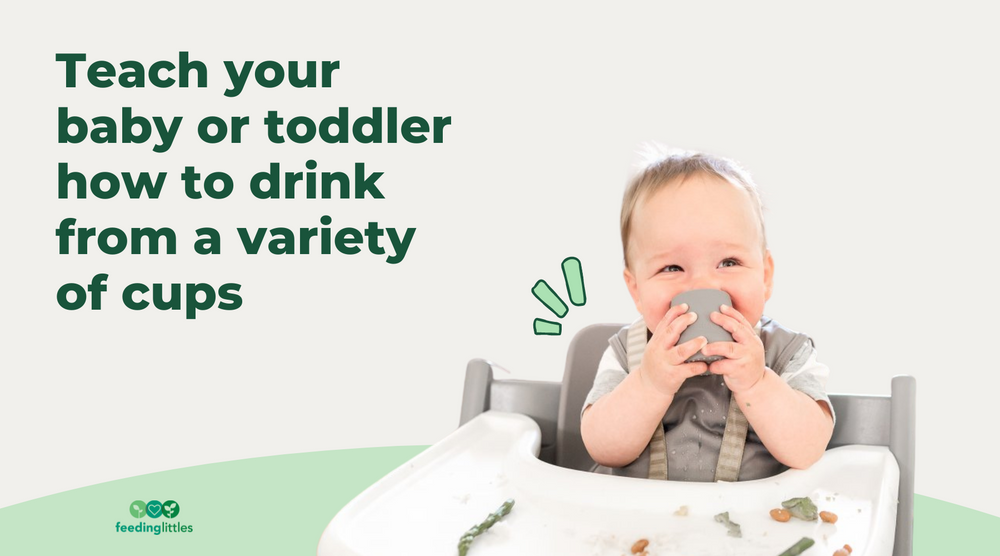
Confused about cups?
You are not alone! One of the most common questions on our private Facebook group and Instagram is “How do I introduce a cup?” We know you have questions about cups given your child’s specific age and stage, so we want to break it down step-by-step so you know exactly how to introduce various cups and what cups are appropriate for your child’s age.
Important Questions To Answer Before We Begin
Before we get to teaching specific cups and how to progress to more advanced skills, we wanted to answer some important questions.
Around 6 months, when your baby starts food (Baby-led Weaning or Traditional Weaning/spoon feeding).
An open cup, then a straw cup (see schematic below).
Open and straw cup promote good oral-motor development and are better than hard spout sippy cups for speech development. Hard spout sippies can prevent proper tongue-tip elevation, which is critical for speech development. Additionally, open and straw cups are the "regular" cups your child will see when they're not at home, so it's important for them to know how to use these types of cups.
When your baby can successfully swallow a small amount of water from an open cup that you assist in holding. They don’t need to be able to hold it or bring it to their mouth independently, we're just looking for them to swallow a small amount of water successfully. This means that you could try an open cup and a straw cup for the very first time on the same day if you'd like!
In each section below, look for the links to individual sections of our Amazon Store for specific cup buying recommendations. Note: it's important to look for a straw cup that does not require a bite to use, as a normal suck pattern does not include biting.
Water or breast milk/formula.
We only recommend juice for constipation (prune, pear, peach juice diluted with water). Otherwise, juice isn’t necessary for babies and young children – fruit is a better option because it contains fiber and is better for their teeth.
No more than 1-2 oz – we don’t want it to displace baby’s milk feeds.
Yes, they are! However, water in a cup has a few important functions:
- Offering water in a cup helps wash down food.
- Teaching cup drinking is an important skill to learn for when baby is eventually weaned from the breast or bottle. (Psst - it makes your life WAY easier if your baby can drink from a cup.)
- A small amount of water helps prevent constipation when food is introduced.
- We want babies to like water so that when they’re older they have a drive to drink it!
In general, we recommend no more than 1-2 oz around 6 months and 3-4 oz max around 9 months. Around 12+ months baby can have as much water as they want but will likely still be drinking breast milk, milk and/or formula along with it (see last question about milk needs, below). Many pediatricians consider a water maximum (starting at 6 months) as number of ounces equaling baby’s age in months; thus, no more than 7 oz of water for 7 months. For most babies this would be far too much water for them to also drink enough of their milk, but it’s a nice maximum guideline if baby is sick or for some reason isn’t drinking their milk.
Start working on transitioning off the bottle around 11-12 months. It may take many months for your toddler to stop using the bottle entirely and transition to cups, but the biggest issue with prolonged bottle use is the potential effects on your toddler’s teeth. If using a bottle before nap or bedtime, try to brush your toddler’s teeth before they go to sleep. We have a detailed Milk and Weaning eBook included in our Infant and Toddler & Kidonline courses that addresses all of this.
Toddlers and kids need more fluid than you think! Below are averages and recommendations of total fluid per day. Read more specifics about your child’s needs – and how to calculate them if you’d like – here.
- 1-3 years: 4-6 cups
- 4-8 years: 7 cups
- 9-13 years: 9 cups (girls), 10 cups (boys)
- 14-18 years: 10 cups (girls), 14 cups (boys)
Babies will vary wildly in how much their bodies need for adequate growth and development. Some babies drink 26 oz a day, while others need over 40 oz. Most babies need at least 20-24 ounces of breast milk or formula until they’re closer to one. This equates to 5-12+ breast feeds depending on baby’s milk transfer. Talk to your doctor, dietitian or lactation specialist if you’re concerned about how much milk your baby is drinking.
This is a tricky question and depends on your child’s overall diet. If you have our Toddler & Kid Course, head to Step 16: Calcium, Milk and Beverages. If your child is drinking cow’s milk or an alternative milk, general guidance recommends no more than 16-24 ounces per day to allow your toddler or child to also eat enough food and not fill up too much on milk. Drinking too much cow’s milk can increase a child’s risk for iron deficiency anemia as well.
Many families continue to breastfeed far into toddlerhood, and some families choose not to use any milk after infancy. Feeding Littles firmly believes that there’s no one right solution for every child – some kids thrive on cow’s milk while others breastfeed far into toddlerhood. Some kids (12+ months) eat high-calcium, high-fat foods and get all of their calories from solid foods and no milk. Every child is different and will vary. Please refer to our Milk and Weaning eBook in both courses for more details about choosing a milk for your child.
Smoothies are OK as of 6 months in small amounts, as long as they don’t contain artificial sweeteners or herbs (found in protein powders). Most straw cups made for thin liquids are too narrow for smoothies and the thicker smoothie consistency gets stuck. Check out our smoothie cup product recommendations HERE!
How do I introduce cups to my baby?
We recommend a specific order of cup introduction to help your baby progress through specific oral-motor skills.
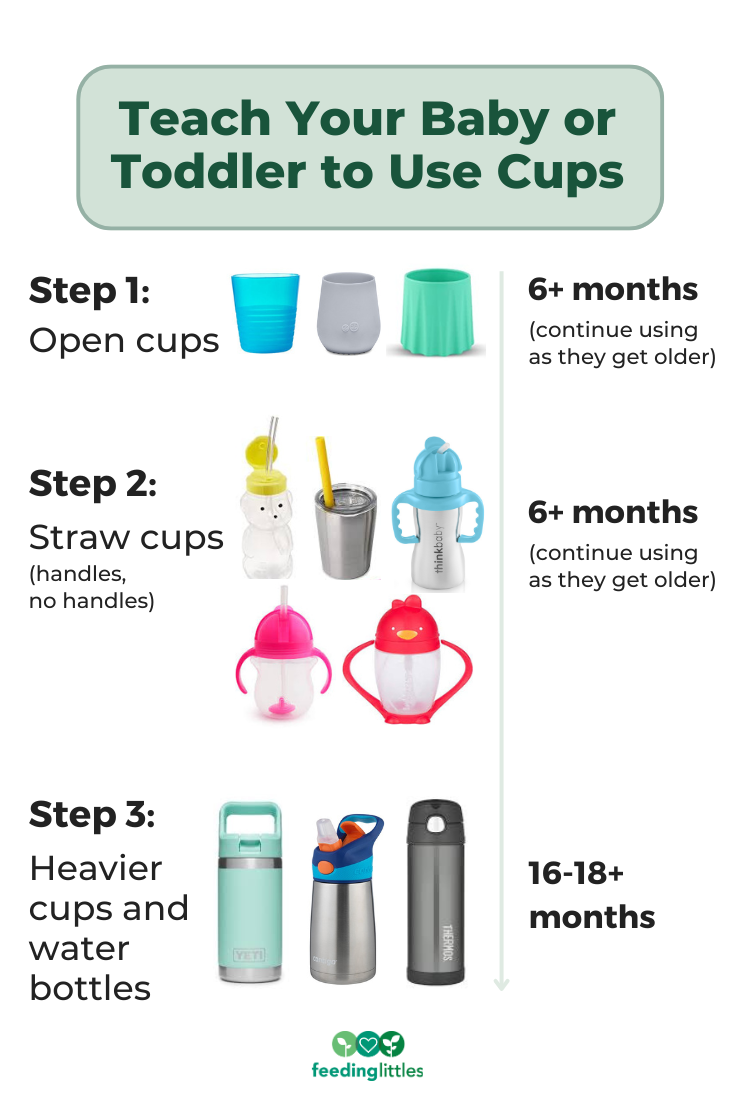
Your baby only needs to learn to drink from two types of cups:
- First, an open cup.
- Next, a straw cup.
Above all else, make sure to start with an open cup first. It really helps your baby learn how to take a small amount of liquid in their mouth and swallow. They have to learn to close their lips around the edge of the cup. We recommend avoiding hard spout sippy cups because they can interfere with the development of your child's mouth and speech.
What about Miracle 360 cups? Parents like the 360 cup, which is similar to an open cup with a silicone membrane lid, because it is less likely to spill. In the past we recommended it as the third cup type to teach your baby. However, recently many feeding specialists have expressed concern about how some kids use this type of cup. For this reason, we no longer recommend it.
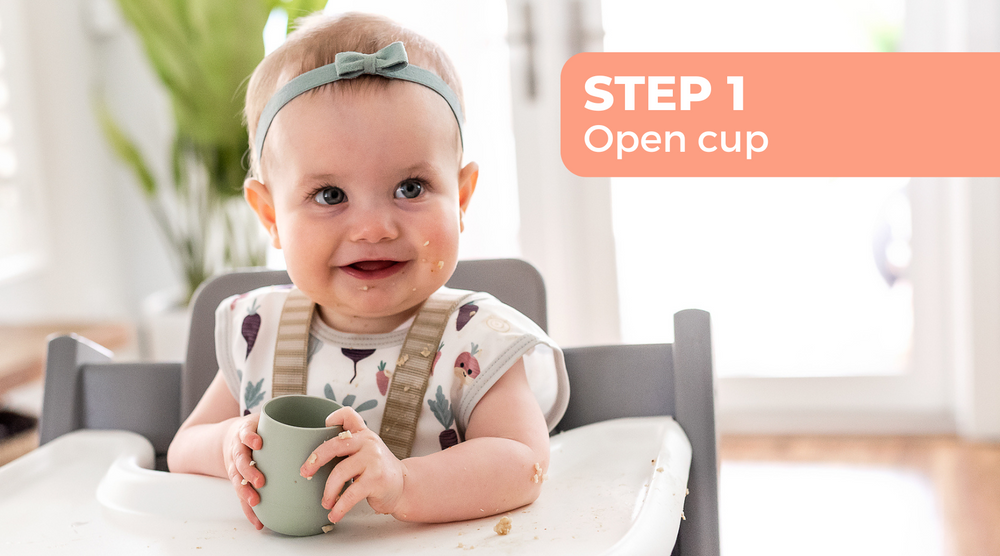
Open cup with adult assistance:
Start around 6 months of age, when your baby starts solid foods. *You might start this earlier if your breastfed baby is refusing a bottle and you need another option. Read more about that here..
1. Get a small open cup without a lip or rim, like a shot glass or an EZPZ tiny cup. Fill it up at least half way with water. You can also use breast milk or formula, but using water helps babies 6+ months get excited about water and can make the transition off breast milk or formula easier in toddlerhood.
2. Position your baby in a seated position in their high chair or on your lap. (Warning: you will get wet if they're sitting on your lap!)
3. Bring the cup to your baby's mouth. Make sure they're watching and paying attention - you want them interested in the process. Don't force the cup to their mouth.
4. Once the cup edge is resting between your baby's lips, tip it back so a small amount of water gets into their mouth. We recommend counting to "one, two" then take it away. "One, two, take it away" is something you can say to yourself each time you try this. It helps prevent baby from getting too much water in their mouth.
5. Bonus technique that Co-founder Judy uses: say, "Ahhh." This encourages your baby to swallow the water so they can mimic "ahhh" as well. They might not mimic "ahh" for a few months, but our clients who use this technique become very proficient at swallowing water from an open cup successfully because they are waiting for the "ahhh" at the end.
6. Your baby might drink some water, or they might let it all dribble out their mouth. Either are fine. This process takes practice! The goal is for them to learn to close their lips around the cup.
Open cup without adult assistance:
As your baby gets older and more experienced with an open cup, they will begin to hold it independently and drink on their own. Many of Co-founder Judy’s private feeding therapy clients are able to independently drink from an open cup by 10 months of age, but every baby is different.
To help your baby drink from an open cup on their own after they’ve practiced with you holding the cup:
1. Give baby a small amount of water in the cup and hand it to them with your hands over their hands (“hand-over-hand” technique).
2. Help them guide the cup to their mouth and drink a small amount of water. Say “AHH” for them to repeat (this promotes swallowing).
3. With your hands over their hands, help them place the cup back on their tray or table. Putting the cup down gives them a break between sips of water that keeps them from drinking too much, too fast.
4. Ask them if they want more – this is where sign language can help!
5. Repeat until baby is doing this on their own! Practice, practice, practice.
To see our list of favorite open cups, click HERE in our Amazon Store.
When can we move onto a straw cup?
As soon as your baby successfully swallows from an open cup using your assistance, try a straw cup! This could be the same day you start open cup drinking - we just want baby to swallow water from an open cup and not dribble it all down their chin before trying a straw cup. Both types of cups are important!
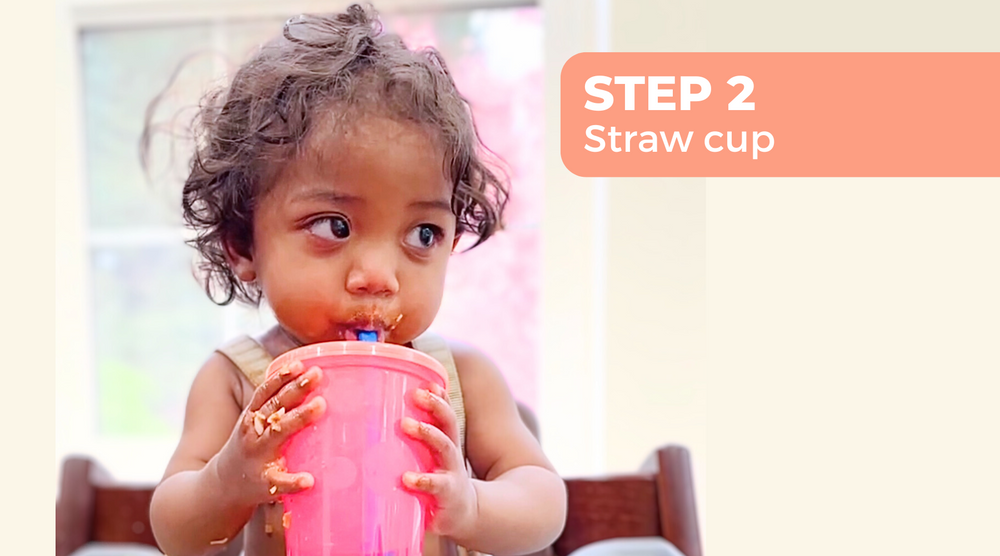
While open cups are wonderful for drinking at home, reusable straw cups are preferred by parents for water drinking while on the go because they’re oftentimes leak-proof (or at least leak-resistant). Some people are moving away from disposable straws for environmental reasons, but it’s still important to teach straw usage because most kids’ cups utilize a reusable straw, and as you’ll learn later that we don’t want to use hard spout sippy cups for oral development and speech reasons. Straws also strengthen muscles in the mouth that are important for eating and talking.
Straw cup with adult assistance:
1. At this point, you’ve already tried an open cup and your baby can successfully swallow a small amount of water. (See the Open Cup section above.)
2. Make sure your baby is sitting upright in their high chair or on your lap.
3. Some babies instinctively know how to use a straw without teaching them. Try a simple straw cup like the Take & Toss or any free-flowing straw you have at home. Bring it to your baby's mouth and see if they will suck from it.
If your baby figures this out right away, great! You can use any straw cup that doesn't require a bite, and continue to practice straw drinking skills. Offer open and straw cups at each meal.
4. If your baby doesn't know how to suck from a straw, try capturing some liquid in the end of a removable straw and place it in their mouth. Sometimes babies just need to understand that there's liquid in straws, and they'll try to suck it out.
If they figure out how to suck from a straw this way, awesome! You can use any straw cup that doesn't require a bite, and continue to practice straw drinking skills. Offer open and straw cups at each meal.
5. If your baby still isn't understanding how to suck through a straw - which is very, very common - the Honey Bear cup is an amazing tool that we use in practice.
Fill the Bear about halfway with water, and make sure the straw isn't sticking out of the lid more than an inch or so. Bring it to your child's mouth, resting the straw between their lips on the front part of their tongue, and squeeze the bear's tummy. Water will come out, and hopefully your baby will close their lips around the straw and suck. Keep practicing, and eventually your baby will initiate a suck on their own when they use the Honey Bear cup.
Once they can successfully suck from this type of cup, use any straw cup that doesn't require a bite, and continue to practice straw drinking skills. Offer open and straw cups at each meal.
Straw cup without adult assistance:
Using straws is kind of like learning to ride a bike - once babies figure out how it's done, they can usually drink from any straw. Keep practicing straw and open cup usage at meals for more practice.
Eventually your baby will start reaching for their straw cup independently. Handled cups can be easier for them to grab, but use whatever cup your baby can easily hold onto and bring to their own mouth.
Ensure that they're placing the straw in the front center part of their tongue, not on either side of their mouth, to practice good positioning.
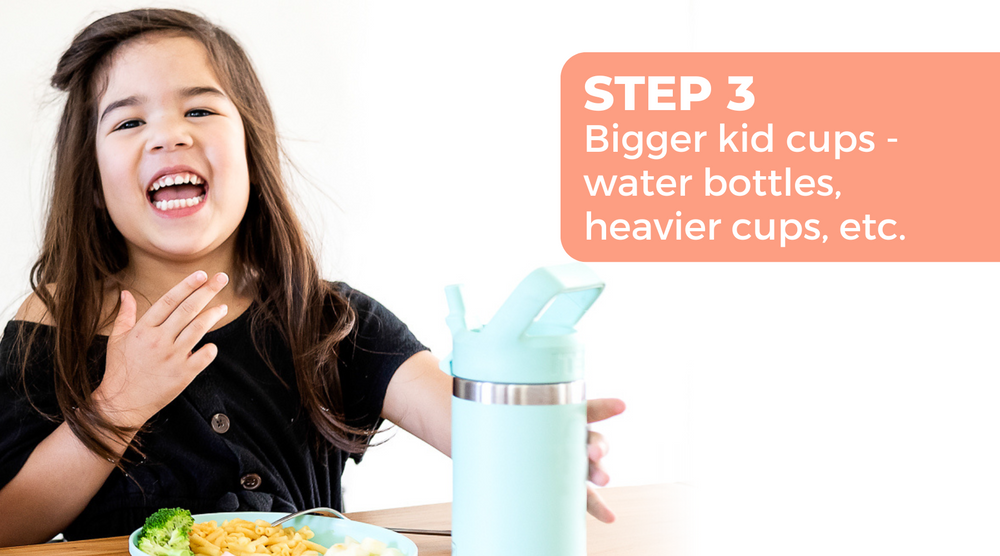
As your child progresses, they may be ready for a “real” water bottle or “big kid” cup! These larger cups and water bottles are great for daycare, preschool or the diaper bag because they’re less likely to leak and hold more liquid.
Some things to consider with heavier or larger water bottles:
- Can your child lift it, or is it too heavy?
- Can they open the top and drink from it independently?
- Are their hands big enough to wrap around the water bottle?
If you’ve answered “yes” to these questions, it may be time for a “big kid” cup!
Our Straw Cup Amazon list has lots of water bottles for kids 16-18+ months, including our favorite brands Contigo, Hydroflask, Yeti and Stanley. If you’re looking for even bigger water bottles for kids 4+ years, head here.
Note: a hard or wider straw as found in the Contigo, Hydroflask and Yeti cups do not pose the same oral-motor concerns as a hard spout sippy cup. They are still straws and promote a normal suck pattern.
What about the Munchkin 360 cup?
As we explained above, we used to recommend the Miracle 360 cup for parents who wanted a more spill-proof option that mimicked an open cup. However, recently some feeding therapists have noticed that the 360 cup can contribute to problematic drinking patterns in some kids:
- Some kids use excessive jaw movements to get the liquid out of the cup. (This is called jaw protrusion.)
- This cup may cause your child’s tongue to rest in the front of their mouth (anteriorly). With “normal” drinking patterns, the tongue is not meant to stick forward.
- Some children tip their head back when they drink from the 360 cup. When they tip their head back, it forces their tongue to work in an abnormal pattern.
But we love the 360 cup! Should we stop using it?
- Developmentally, it’s important for your child to drink from an open cup and a straw cup.
- If they’re using a 360 cup, try to switch to an open or straw cup for the majority of their cup drinking.
If your child cannot or will not drink from anything but a 360 cup, here are some tips:
- Pull off the silicone top lid of the 360 and offer it to your child with water or milk in the cup. This turns it into a modified open cup. Your child may need some time to learn to modify their drinking pattern and neck position.
- Note: ensure that your child is sitting upright when drinking from a cup. If they were used to drinking it reclined or laying down, modifying the cup may cause the liquid to pour out onto them.
Just remember...open cup first ("one, two, take it away...AHH") then straw cups that don't require a bite. That's it!
We hope this has helped you use cups with your family! Cheers!
